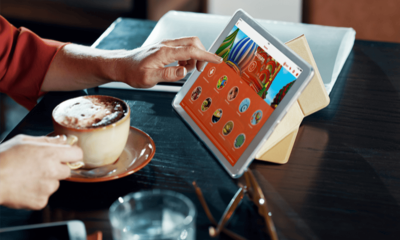Investing
Creativity Isn’t Just Something You’re Born With — It’s a Skill You Can Develop. Here’s How.

Entrepreneur
For a brand to survive and thrive in a competitive marketplace, it must harness the power of creativity and innovation. When a brand ceases to innovate, it risks becoming mundane and losing its unique appeal, thereby surrendering its market share to a more imaginative competitor.
With that said, few of us know how to cultivate this creativity in our brands or ourselves individually. Contrary to popular belief, creativity is not a rare gift bestowed upon a select few “artsy” individuals. Instead, it should be considered a skill that anyone, including you, can hone and develop. All it takes is practice and a deeper understanding of how our brain and consciousness function.
As a meditation teacher and a student of consciousness and leadership for over a decade, I’ve learned that fostering a culture of creativity in our businesses and societies must start at the individual level. Creativity cannot be forced or bought about using conventional logic and reason. Each of us plays a role in cultivating creativity, and this article will guide you on how to nurture this skill for your business and personal development.
Related: How To Use Entrepreneurial Creativity For Innovation
What is creativity?
Creativity is the ability to generate or recognize ideas, patterns or possibilities to bring about novel outcomes. Becoming more creative entails being detached from our logical, linear thinking and embracing the non-linear nature of our consciousness, individually and collectively.
To further showcase this non-linear nature of creativity, let’s explore the creative process in a four-step linear sequence starting with:
- Priming: We must first prime our minds with the information, tools and skills we want to get creative with, typically with a vision of our desired outcome.
- Free association: After we prime our minds, the next step is to let our ideas incubate and freely associate with each other. This can involve intentionally contemplating our ideas and doing something completely unrelated, returning to the creative endeavor later. Embracing positive distractions is encouraged!
- Inspiration: Given that we’ve done sufficient mental priming and our state of mind allows us to freely associate, we inevitably will find ourselves with the spark of inspiration — a novel idea to bring about the outcome we want.
- Execution: Lastly, we test our ideas. If they miss the mark, we iterate to step 1 or 2 to refine our ideas or desired outcomes.
As mentioned in step 3, finding our spark of inspiration depends on how well we prime our minds with the information and tools we want to create with and the state of our minds before we go into the creative process. How we prime our minds is generally dependent on the individual creative endeavor, so for the remainder of this article, we assume you are competent and skillful with the external knowledge and tools needed for an innovative vision. Furthermore, we will explore the non-linear dynamics of our mental state and how we can overcome the common barriers we find on our road to creation.
Related: How to Be More Creative in Your Business
Our emotions measured and scaled
In my years of research on the topic, I came across the works of Sir David R. Hawkins, M.D. PhD, a man who spent decades testing and calibrating conscious experiences and sharing his findings with the world. In a nutshell, he made a significant discovery that our emotional experiences produce electrical energy in our body, and the power of said energy can be measured on a logarithmic scale.
Additionally, our negative emotions were measured on the lower end of the scale, while our positive ones were on the higher end. As crazy and irrational as our emotions may seem, a hidden order can be found in our disorder, and we can work to optimize our lives for heightened creativity and inspiration.
Moving from force to flow
Given that we aren’t in destitute situations or the throes of grief, disparity, and shame, we are typically the ones who get in our way. In a world where we often hyperactively hustle and burn ourselves out to make things happen, we forget that finding alignment with inspiration involves letting go and allowing things to unfold and fall into place naturally. This hyperactive energy and the negative emotions fueling it are prevalent in today’s work culture and are counterproductive to being genuinely creative.
The following are four tips I share with clients to help them move from force to flow:
- Embrace Stillness: Learn to sit with yourself and do nothing. Creativity has less to do with active doing and more with allowing your mind to reveal itself spontaneously.
- Understand your why: Modern neuroscience has shown us that living in our purpose engages the limbic brain, which governs behavior, decision-making, motivation, emotional regulation, and processing. Conversely, focusing on our actions interacts with the neocortex, which is responsible for rational thought and analytical processing. Aligning with the mission behind your work is thus more potent than working for the sake of working.
- Detach from your ego: When unchecked, the ego leads us to live in a state of survival. Led by our primal emotions of desire, anxiety, anger and pride, we create situations that perpetuate these states and block us from accessing true creativity in our lives. The key to detachment is understanding our limiting beliefs about ourselves and the world and replacing them with higher principles and values. I wrote the following article on how to do precisely that.
- Be of service: If your only aim is to take from the world and not contribute to it, you’ll remain in survival mode, regardless of your possessions or income. When we focus on understanding human nature and bringing about the highest good for others, we naturally cultivate compassion, inspiration and, thus, creativity in our individual lives and the world around us.
Related: I Pitched 300 People a Day For 1 Year — and Learned This Firsthand
As I’ve mentioned before, creativity is a skill anyone can develop with intentional practice and an open mindset. You can tap into your full creative potential by aligning your emotions, understanding your purpose and giving your mind the freedom to explore. In harnessing these principles, I hope you inspire innovation and achieve meaningful success in your personal and professional life.
Read the full article here

-

 Side Hustles6 days ago
Side Hustles6 days agoExpand Your Global Reach with Access to More Than 150 Languages for Life
-

 Side Hustles5 days ago
Side Hustles5 days agoKFC Announces Saucy, a Chicken Tenders-Focused Spinoff
-

 Side Hustles6 days ago
Side Hustles6 days agoThis AI is the Key to Unlocking Explosive Sales Growth in 2025
-

 Investing5 days ago
Investing5 days agoPalantir, Anduril join forces with tech groups to bid for Pentagon contracts, FT reports By Reuters
-

 Side Hustles4 days ago
Side Hustles4 days ago4 Ways Content Can Make or Break the Customer Experience
-

 Side Hustles4 days ago
Side Hustles4 days agoHow to Build a Legacy of Leadership in Your Business in Six Proven Strategies
-

 Investing6 days ago
Investing6 days ago14 lessons from 2024 to remember in 2025: BofA By Investing.com
-

 Passive Income2 days ago
Passive Income2 days agoWhy Emotional Intelligence Is the Key to High-Impact Leadership


















